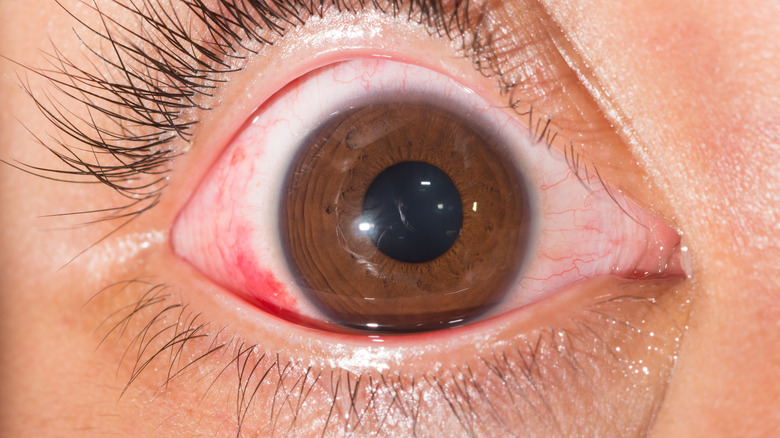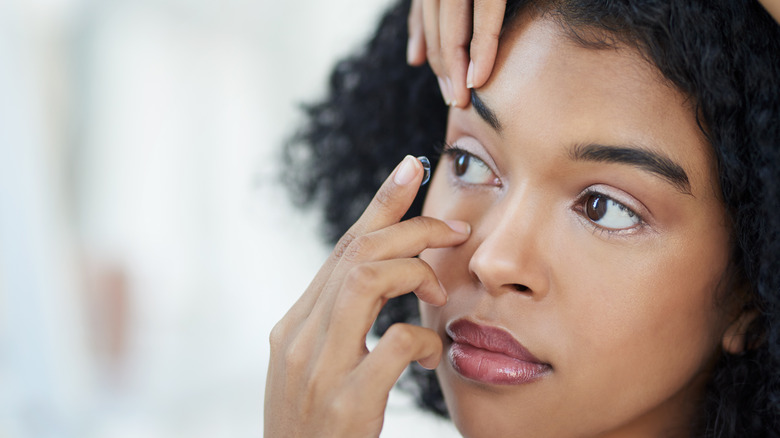What It Means When You Have Veiny Eyes
In order for our eyes to receive the blood supply they need, each eyeball is connected to one main vein and one main artery with smaller offshoots throughout the rest of the eye (via NVISION Centers). When looking in the mirror, you'll see that the majority of your eyeball's surface area is taken up by the sclera, or the whites of the eyes, according to the American Academy of Ophthalmology. Normally, the sclera should be white in color because these small offshoots from the main vein and artery can't be seen.
If you've noticed that these smaller veins have begun to spread across the whites of your eyes, you may be wondering if their appearance is cause for concern. Some cases of veiny eyes that are caused by the dilation of blood vessels may be temporary. This condition, which is often referred to as "bloodshot eyes," can occur due to eye strain, a poor night's sleep, or a minor irritant that may have made its way into your eye. Those who suffer from allergies may also be susceptible to reddening of the sclera. Other causes of veiny eyes might include overexposure to the sun's rays, trauma to the eye, or cases of dry eyes.
Veiny eyes could mean one of these conditions
Bloodshot eyes generally appear red in color. However, another reason that you might notice such reddening in the sclera is if you develop a subconjunctival hemorrhage, according to Mayo Clinic experts. This occurs due to blood vessel breakage and shows up as a red blotch on the eyeball. Anything from throwing up to a coughing fit may cause damage to one of these tiny blood vessels. A subconjunctival hemorrhage is not usually a cause for concern since it generally resolves on its own within 14 days.
While we've mainly been talking about veins within the whites of the eyes, the appearance of red veins may alternatively develop within the iris if a person experiences rubeosis iridis. According to a 2017 case study published in The Pan African Medical Journal, the condition is characterized by the emergence of abnormal blood vessels on the surface of the iris due to hindered blood supply to the retina. Rubeosis iridis has been linked with diabetes, retinal vein occlusion, and chronic retinal detachment, among other conditions. A 2012 case report published in the Journal of Vascular Surgery also found a relationship between rubeosis iridis and carotid artery disease, in which the accumulation of plaque obscures blood flow to the head and brain (per Cleveland Clinic).
Tips for reducing the appearance of veiny eyes
If your veiny eyes are unrelated to a health condition, there are things one can try at home to help reduce redness. For people who wear contacts, try taking a break from your lenses and put on a pair of glasses instead, suggests NVISION Centers. It may be the contacts that are responsible for your red, irritated eyes. Eye drops may also help lessen eye irritation. Alternatively, implementing healthy habits on a daily basis can also help prevent the development of veiny eyes. This includes getting adequate sleep, taking routine breaks from screens, drinking plenty of water, managing allergies, and refraining from drug or alcohol use.
In the event of eye pain, sensitivity to light, vision changes, or an eye injury, be sure to speak to your physician. The same is true if you notice potential signs of an eye infection — such as redness, pain, itching, or blurry vision — or if redness persists for more than a couple of days (per Medical News Today).



